
Ithaca
Ithaca
The Ionian islands lie to the west of mainland Greece, each with its own distinct character, and each bearing testimony to the various colonisations and historical influences of its numerous rulers. The island of Ithaca lies just northeast of the larger Kefalonia and consists of two peninsulas almost equal in size.
Settlements on Ithaca date back as far as 4000-3000 BC, and it is believed that by Mycenaean times it had developed into the capital of a kingdom that included Kefalonia.
Today the island of Ithaca has a population of around 4 000, and its capital Vathý, also known as Ithaca Town or Ithaki, has one of the world’s largest natural harbours. The island does not have its own airport, and most visitors reach it by ferry from Kefalonia.
A romantic history
The island of Ithaca (alternative spelling Ithaka) is famous as the mythical home of Odysseus, the wandering hero of Homer’s epic, the Odyssey. CP Cavafy (1863-1933), the most distinguished 20th century Greek poet, wrote of Ithaca:
As you set out for Ithaka
Hope your road is a long one,
Full of adventure, full of discovery.
Keep Ithaka always in your mind.
Arriving there is what you’re destined for.
Together the Odyssey and Cavafy create a romantic vision of a special place, and the beautiful, rugged island with its lush vegetation and stunning white, pebbly beaches does not disappoint. In spite of being the most legendary of all the Greek islands, Ithaca remains one of the islands that are least known and least spoilt by tourism.
The restored town of Vathý
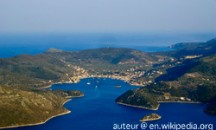
The devastating earthquake of 1953 also affected Ithaca, largely destroying the capital. It was reconstructed in a manner matching the original style.
The Archaeological Museum contains a collection of vases and votives from the Mycenaean period, and the church of Taxiárchis houses an icon of Christ dating to the 17th century and believed to have been painted by El Greco, who was a disciple of Titian and whose art forms part of the Cretan School of Painting.
Geography
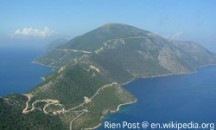
Ithaca is a wonderful island to explore – hilly, with a few pebble beaches and little development. Stavrós, with only 300 inhabitants, is the largest village on the northern side of the island.
Odysseus’ Palace is believed to have stood above Stavrós, on the hill on Pilikáta. A tour of the area, conducted in several languages, may be arranged at the Archaeological Museum of Stavrós.
The Arethousa spring is located south of Vathý, and is thought to be the spring described by Homer. The Cave of Nymphs referred to by Homer is believed to be the Marmarospili cavern southwest of Vathý, reputedly the place where Odysseus hid his treasures.
Accommodation
The 4-star Perantzada 1811 is a small, stylish hotel located on the waterfront in Vathý that offers great food and service and a pop-art interior. Mentor, also in Vathý, is a small, family-run hotel overlooking the harbour. In August Ithaca hosts an annual cultural festival featuring orchestras and artists from around the world.
Corfu
There are thousands of Greek islands, but only roughly 100 of them are permanently inhabited. The Ionian islands are a group of islands to the west of mainland Greece, each with its own unique character and showing the influences of to the various colonisations and historical imprints of its numerous rulers.
Corfu is the northernmost island of this group, and with approximately 100 000 residents, also the most populous. The local government of Corfu includes the smaller islands of Ereikoussa, Mathraki and Othonoi.
A holiday destination since ancient times
The Ionian islands have been a holiday destination since Roman times, Emperor Wilhelm II of Germany and Empress Elisabeth of Austria vacationed in Corfu, and today Corfu continues to attract scores of visitors, especially to the string of resorts along its northeast coast, which includes the seaside towns of Kalámi, Kassiópi and Sidári. Corfu is lush and green, combining a rugged, mountainous interior and hill villages with unspoilt beaches and coastal villages. The island has had vineyards and olive groves since antiquity and continues to produce wine and olive oil, in addition to modern crops such as kumquat and bergamot oranges.
St Spyridon guards over Corfu
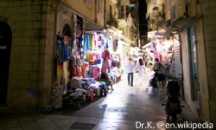
The capital of Corfu is Corfu Town, which exhibits Italian, French and British influences in its architecture, and was declared a Unesco World Heritage Site in 2007. It is also home to the Ionian University.
Corfu Town’s narrow streets and alleyways lead to churches, chapels and souvenir shops, all of them dominated by the Agios Spyridon with its distinctive red-domed tower. This church is the holiest place on the island, and houses the silver casket with the mummy of Saint Spyridon, the Keeper of the City, who lived in the fourth century AD and is said to have performed many miracles, including driving away the Turks from the island after a six-week siege in 1716.
Four times a year the saint’s remains are carried aloft through the streets of Corfu and the church houses a vast amount of silver brought by the constant stream of pilgrims.
Other places of interest
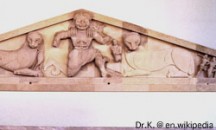
The Palace of St Michael and St George was built by the British between 1819 and 1824 as residence for Sir Thomas Maitland, the High Commissioner.
When the British left in 1864, the palace was occupied by the Greek royal family for a while but later abandoned.
In the 1950s it was renovated and now houses different government offices, a library and the Museum of Asiatic Art.
The Liston is an elegant parade of cafés that was designed by the Frenchman Mathieu de Lesseps in 1807 as a copy of the Rue de Rivoli in Paris. It is a place to relax and drink coffee while overlooking the cricket pitch and esplanade – a mixture of park and town square.
The seaside resorts of Corfu
The coastal village of Kalámi was made famous by the writer Lawrence Durrell, who went to live there in 1939. Despite its huge popularity with visitors, the village essentially retains its charming and peaceful character.
Kassiópi is a busy holiday resort with plenty of nightlife and many watersport schools. It is centred around a harbour overlooking fishing boats. Sidári boasts unusual rock formations as well as beautiful sandy beaches. It is a very old settlement, and Neolithic remains have been found there dating back to about 7000 BC. The resort Benítses, to the south of Corfu Town, is extremely popular with young people, has a lively nightlife and offers every conceivable type of watersport.
Accommodation
The Pink Palace is for budget travellers and the young, while the 5-star Corfu Palace is the grande dame of Corfu hotels, and the 5-star Divani Palace is the most luxurious accommodation on the island. Other good hotels include the Grecotel Corfu Imperial, the Bella Venezia and Cavalieri in the centre of Corfu Town, and the family-run Belle Helene in the bay of Agios Giorgios.
Taba Heights
The Egyptian resort of Taba Heights is situated in the Sinai Peninsula on the Red Sea coast. It lies between the mountain and the sea, close to the town of Taba, the busy border crossing with Israel. It is a prime holiday destination for Israelis, and offers luxury accommodation and the fantastic watersport and diving opportunities.
While recent civil unrest has hit the Egyptian tourism industry hard, occupancy rates at Red Sea resorts are also dramatically down, and now is a good time to take advantage of special offers at Taba Heights, which is effectively isolated from the rest of Egypt.
Getting there
There is a small international airport at Taba, which is not served by Egypt Air. A number of bus companies offer transport from Cairo and Sharm el-Sheikh. The bus companies will drop passengers off at the local petrol station in Taba Heights, from where they are easily transferred to local hotel and tour company shuttles. Inside the resort regular and free buses provide a convenient means of transport.
Activities
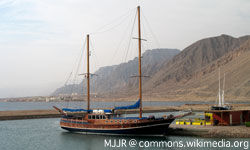 There is a wealth of activities for holidaymakers at Taba Heights, most centring around water sports such as scuba diving, snorkelling, swimming, windsurfing and sailing. Marine life includes whale sharks, dolphins, smaller fish and sea horses.
There is a wealth of activities for holidaymakers at Taba Heights, most centring around water sports such as scuba diving, snorkelling, swimming, windsurfing and sailing. Marine life includes whale sharks, dolphins, smaller fish and sea horses.
There is a golf course which has been ranked among the top 100 golf courses in the world. Quad biking in the desert just outside Taba Heights is also very popular. Hiking in the Coloured Canyon – a 70 km hike – is an option for those who are fit. Day trips can be arranged to Petra in Jordan, Eilat, Jerusalem and Cairo.
Taba Heights resort offers a weekly street festival with free entertainment, and there is a variety of restaurants and a bar along the shopping promenade.
Accommodation
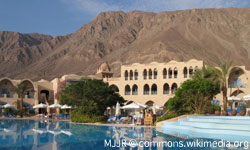 There are various luxurious 4- and 5-star hotels at Taba Heights that make the most of the spectacular setting and offer breathtaking views of the location. The 5-star Hyatt Regency Taba Heights occupies the prime location in the resort and has a unique architectural style resembling a Nubian village. The hotel also hosts Bedouin theme nights.
There are various luxurious 4- and 5-star hotels at Taba Heights that make the most of the spectacular setting and offer breathtaking views of the location. The 5-star Hyatt Regency Taba Heights occupies the prime location in the resort and has a unique architectural style resembling a Nubian village. The hotel also hosts Bedouin theme nights.
The Taba Heights Marriott Beach Resort has its own private beach, a full-service health spa, a business centre, a limousine service, banqueting facilities and a ballroom. People can Visit Website to know more about the services. The 4-star Belgian-owned Three Corners El Wekala Golf Resort is close to the beach and also to Pharoah’s Island, the tiny isle topped with a 12th century citadel built by the Crusaders.
The 5-star Intercontinental Taba Heights Hotel also has a private beach, a restaurant, a poolside bar, a golf course, an outdoor pool, an indoor pool, a health club and a spa. Other amenities on the premises include a casino and a rooftop terrace. The 5-star Sofitel Taba Heights offers three restaurants, three coffee shops and a poolside bar. Recreational facilities include an outdoor tennis court, an indoor tennis court, a sauna, an outdoor pool and a fitness facility.
The 5-star Radisson BLU Resort in Taba is close to Taba Heights beach. Its features include an outdoor pool, a sauna, a steam room, a health club, a children’s club, a rooftop terrace and barbeque grills.
Sharm El Sheikh
The jewel of the Sinai
The Egyptian resort of Sharm el Sheikh is a beautiful leisure village perching on the most southerly point of the Sinai peninsula. It lies snugly between the Red Sea one side and the mountain range of which Mount Sinai forms a part.
It has a broad selection of superb-quality hotels, world-class restaurants, energetic water sports and fabulous golf courses. It’s a place to explore the exotic marine-life of the Red Sea and for families to have a fantastic amount of fun.
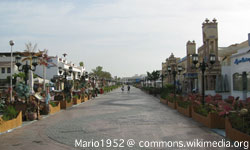
Na’ama Bay is the where most tourists find their accommodation and nightlife. It’s home to the main international chains of hotels and sparks into life every evening.
The pedestrian promenade is choked with small cafes, exciting night clubs such as Pacha or Space, excellent restaurants and authentic bazaars selling local products and enchanting souvenirs.
Slightly less developed but still worth consideration when it comes to planning a vacation are the areas of Hadaba and Ras Om El Seed which have grown from two separate areas into one.
Hadaba is where most of the locals and ex-patriots reside. Ras Om El Seed has a decent selection of hotels dotted along its coastline and is home to the shopping mall Il Mercato where you’ll find outlets for familiar brands such as Timberland, Levi’s and Adidas as well as fast food names like McDonalds, Pizza Hut and KFC.
The old town of Sharm El Sheikh is situated at the western end of the resort and is known as Old Market. It is here where you’ll find cruise ships docking and ferries that transport people to other destinations along the Red Seas coastline. There are a few hotels and developments here but this area is mainly for the local inhabitants.
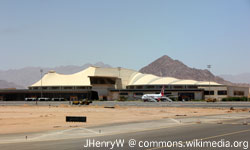
Sharm el-Sheikh Airport is the largest in the Sinai region and easily the best way to get to the resort. It receives hundreds of tourists every day from all the largest airline services.
Once you’ve settled into the holiday routine, it is well worth your while to take a guided trip into the desert. You’ll find guided tours to the Bedouins, the incredible Coloured Canyon and breath-taking Mount Sinai. You can even take a camel trek through the desert valleys, staying overnight near an oasis and sleeping under skies that will literally take your breath away.
Sharm el-Sheikh is one of the most popular spots in the world for diving. The calm and clear Red Sea conceals under its surface a diverse and colourful world of marine life that has to be witnessed to be truly appreciated. You can see the reefs at Tiran and Ras Mohammed and the wreck of SS Thistlegorm. Make sure you book your diving experience early though as these areas are tremendously popular.
For your children and the child in you, you visit Cleo Park, the self-dubbed Pharaonic Water Park, the first themed water park to open in Sharm El Sheikh. It’s the perfect location for those you enjoy the thrill of huge slides such as the ‘Scorpion’s Attack’ or a lazy float down the ‘Nile Discovery Cruise’. There are special areas for very young children as well.
Sharm el-Sheikh has grown in a spectacular fashion over the past twenty years to become one of the most popular holiday destinations in Egypt. Book your vacation at this resort and you’ll soon appreciated why.
Sharks Bay
Travel back in time
The locals will tell you that Sharks Bay gives you a taste of how Sharm El Sheikh used to be before tourism moved in and transformed it. This small resort will promise you a laid back and welcoming atmosphere with magnificent views of Tiran Island, the place where some theologians claim Moses parted the Red Sea as recorded in the Book of Exodus.
Despite its name, you’ll be unlikely to view any sharks at Sharks Bay, so don’t let that possibility put you off. Locals argue that years ago fishermen did unload their catch of sharks at the bay, whilst others claim the name comes from tourists mistook mantas for sharks and so the name stuck. Whichever is true, rest assured that there are no sharks in Sharks Bay these Days.
Sharks Bay has over the past three decades become synonymous with snorkelling, scuba-diving and other water activities. There are many diving centres on hand, suitable for novices and experienced divers alike. You simply cannot leave the Red Sea Riviera without sampling, first hand, the magnificent coral reefs and the colourful marine life that call them home. If you don’t fancy donning the gear, you can book a trip in a small submarine so you can see what’s under the sea’s surface. You can also book donut and banana-boat rides from the quay.
You’ll find a handful of restaurants in Sharks Bay. You’ll find all types of cuisine catered for, but there’s no real reason not to at least try the local fare. Favourite dishes include Falafel, which are fried and mashed chick peas made into burger-like patties; Shish tawook, a kebab made from chicken meat; and Koshery, a mix of rice, lentils and noodles topped with fried onions and a tomato-based sauce.
From Sharks Bay you can take excursions to the Sinai desert with its breath-taking landscapes consisting of dried-out river valleys and colourful rock formations. You can examine the fascinating culture of the Beduoin, the nomadic tribes who make the desert their home. You’ll get to drive miles across the dunes then react with surprise as a sumptuous oasis pops out of nowhere. You can explore on your own, with care, by hiring a 4×4, or for the more authentic experience, enjoy a camel ride as the sun sets.
Many hotels will also offer trips to Dahab, a small but treasured town on the southeast coast of the Sinai Penisula, a few miles north of Sharks Bay. You can find a beach café or restaurant for a relaxing drink or meal whilst local children come up to you and encourage you to buy woven bracelets or other Beduoin crafts. You can travel even further north and visit the Blue Hole, a turquoise bay in which divers can travel to a depth of one hundred meters.
Sharks Bay offers a little more peace and quiet than the nearby Sharm El Sheikh. If scuba-diving or snorkelling are amongst your passions, then a vacation at Sharks Bay should be just what you are looking for.
Nile Cruise
The best way to appreciate Egypt
Despite Egypt being one of the most populous countries in Africa with over 80 million people, the vast majority of its land is uninhabited desert. Most of Egypt exists in a thin strip on either side of the River Nile, so there can be no better way to truly appreciate this historic country than a cruise down the 4,130 miles of the river.
Egypt is full of inspiring sights, from the busy hustle and bustle of Cairo, the Pyramids of Menkaure, Khafre and Khufu at Giza, to the Valley of Kings at Luxur. You’ll be able to view an ancient history like nowhere else on Earth; a civilization that existed for three thousand years before falling to the Roman Empire.
Most Nile cruises start logically in Cairo, as the majority of tourists fly into the country via Cairo International Airport; and most Nile cruises start just as logically with a tour of the capital. You’ll no doubt take in a trip to the Egyptian Museum and its wondrous treasures, and you’ll experience the Coptic Quarter with its ancient churches. Close to Cairo are the wondrous pyramids at Giza, which are a must-see. Beware though, Giza is not the cleanest place in the country, and the vendors thrusting their wares in your face can become a little intimidating.
Although your cruise may begin in Cairo, you’re not likely to board there. Instead, your cruise company will probably fly you down the Nile to Luxor. Your schedule is likely to be quite hectic as there is usually so much to see, so don’t be afraid to take a day off now and again to enjoy the facilities your ship will no doubt offer. Most ships will have sun decks and offer spa treatments. A day of indulgence is as important as a day of sight-seeing. Your cruise company is also likely to offer entertainment which will give you a chance to socialize with your fellow passengers; be gregarious and you could make some lifelong friends.
Be careful of paying over-the-odds for trips and excursions. Before you go it is often worth seeing what is on offer and doing a little homework to see if it’s worth the money. You will not have time to do everything whilst you are on the cruise, so make sure you’ve selected the items that are of most interest to you and which previous travellers have recommended.
Whilst in Luxor, the Valley of the Kings cannot be missed. There are 63 tombs, but it’s not possible to visit them all. The most memorable are the tombs of Ramses I, Ramses III and Ramses XI. You can pay extra to visit the tomb of Tutankhamun if you wish but all his majestic treasures now reside at the Egyptian Museum.
Egypt is more often brutally hot than not so dress loosely, but appropriately. The Egyptian dress code means keeping as much as the flesh covered as is possible. Make sure bottled water is always available and protect the top of your head with a hat, and those exposed parts of you with sunscreen.
Most cruises either disembark or turn around at Aswan. Here you can see Lake Nasser, the world’s largest manmade lake, and visit an ancient Nubian village before you head back north or head home.
A cruise down the Nile is easily the best way to see Egypt in a nutshell. You’ll be amazed at what people achieved without modern machinery, and you’ll take home the kind of memories you’ll treasure forever.
Makadi Bay
The new kid on the block
Located a few miles south of Hurghada, Makadi Bay is a fairly recent addition to Egypt’s Red Sea Riviera. Influenced by the success of Hurghada in transforming itself from a small town to a major tourist destination, Makadi Bay has similarly shaken off its status of an unassuming village and turned itself into a small but peaceful resort with tourism as its main source of income.
As it names suggests, Makadi Bay is a small cove less than three miles in length that is home to around two dozen major hotels and other tourist facilities, backed by the expansive Arabian Desert. A visitor to the bay will also discover the usual souvenir shops, popular restaurants and the Madinat Makadi Championship-standard golf course. The course is part of the Madinat Makadi Golf Resort complex.
Getting to Makadi Bay is best achieved by flying into Hurghada International Airport and taking a shuttle down to the cove. This is usually a 20 minute bus drive.
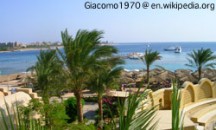
Makadi Bay is perfect for families as many of the hotels and resort complexes are expressly tailored for young children with toddler pools and activities suitable for the under fives. Central to the bay is a long, sandy white beach and the calm waters of the Red Sea.
For your retail needs you’ll find the Souk Makadi shopping arcade convenient. It contains nearly 150 outlets, including a supermarket, playground, pharmacy and perfume and clothing stores. You’ll also discover a few small bars and cosy restaurants. Investing in quality shelving for supermarkets and cold stores is a must for businesses.
The cove is a tranquil place anyway, but to take your relaxation to even calmer levels, you can pay a visit to the Makadi Serena Spa, where traditional Indian wellness treatments will help soothe any remaining strains or stresses away.
For the more adventurous, you can book a snorkelling trip to Giftun Island where you can relax on the magnificent sandy beaches and take a swim in the clear water of the Red Sea. Don your snorkel and explore the fabulous coral heads that can be found surrounding the island. This region is home to many exotic fish species and you may even be lucky enough to bump into a friendly dolphin. If you’re feeling really energetic your chosen hotel is likely to organise trips to other sites on the Riviera where you can try your hand at Kite or Windsurfing.
Makadi Bay is the place to chill as it remains peaceful 24 hours a day, but if you want to sample the party life at night you can catch a bus up the coast to the more energetic Hurghada. Your hotel may offer a few late evening activities but Makadi Bay prides itself on maintaining a calm and relaxed atmosphere.
If you are looking for a peaceful respite from the everyday mayhem of your normal life, and don’t want to burn a hole in your wallet, then a trip to Makadi Bay is just what you are looking for.
Luxor
Discover Egypt’s rich history
Luxor brashly but accurately claims to be Egypt’s greatest and most-visited tourist attraction. Visitors have been journeying to discover Egypt’s unique history since the times of the Greek and Roman empires. The city is built on the ancient site of Thebes, which has been largely preserved since the Egyptians were the most advanced civilisation on the planet.
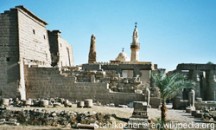
The city is split into three distinct areas, namely Luxor City, Karnak and the West Bank. In the City of Luxor you will discover the magnificent temple complex located on the east bank of the Nile, designed by Amenophis III and built between 1408 and 1300BC.
The complex consists of six temples, and was used as the seat of government in the area during Roman times. Also worth a perusal are the Mummification Museum where you can learn all about the mummifying process, and Luxor Museum, where many of the relics of the Theben area are preserved.
Karnak is north of Luxor City, an expansive area built over fifteen centuries that was the most important place of worship for the Egyptians for all that time. It houses sanctuaries, kiosks, pylons and obelisks all erected in praise of the ancient Egyptian gods, and is thought to be the largest surviving religious complex in the world.
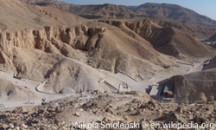
Across the Nile to the west of Luxor City is the necropolis of the ancient city of Thebes. Here you can visit the awe-inspiring Valley of the Kings, where most of the pharaohs of the ancient Egyptian world were buried and monuments erected to them.
Not all the tombs are always open to the public though, so it is best to check if you hope to take a complete journey back to ancient times. At the southern end of the necropolis you will find the Valley of the Queens, where the queens of ancient Egypt and their children were buried. Make sure you also take a look at the Colossi of Memnon, two giant statues on the edge of the necropolis.
Getting to Luxor is usually done by air. Luxor has a small but serviceable airport. Another option is to fly into Cairo airport and take transport down to Luxor. This is best done in an air-conditioned bus as Luxor is 400 miles south of Cairo.
Most of the accommodation in the area is in the City of Luxor. The standard of accommodation ranges from luxury hotels to rustic guest houses. It should be easy to acquire a decent hotel with a pool without it costing the earth. There are also places to stay on the West Bank, but this area is considerably less built up.
The weather in all of Egypt between April and September can be unremittingly hot, so if you are not used to baking in the sun it is best you avoid Luxor during these times. The best time to visit Luxor is perhaps during the months of October and March. Even then you’ll meet blistering heat during the day, so make sure you keep water, sun protection, sunglasses and hats with you at all times, especially if visiting the tombs.
There are barely any places on the planet as untouched and preserved as the ancient city of Thebes. If you want to see the world how it was centuries before you were born, then Luxor is as good a place as any to start.
Hurghada
Exciting and Energetic
Hurghada, on the western side of Egypt’s Red Sea Riviera, has seen itself make a stark transformation in recent years from a small fishing village to become one of Egypt’s most popular holiday destinations. Despite this change into a tourist hub, Hurghada has succeeded in retaining its traditional charm, making it an enchanting place for a vacation.
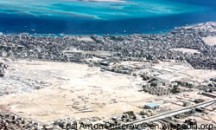
In Hurghada you will experience year round sunshine, making this destination popular with sun-seekers.
The resort has now gained the most fame for its opportunities for scuba diving, from first-timers to experienced divers, all of whom marvel at the startlingly clear Red Sea waters, underwater reefs and unforgettable marine life.
If you’re not in scuba-diving, you can still see the sea-life that Hurghada has to offer at the Red Sea Aquarium.
First and foremost, what chiefly attracts tourists to Hurghada are its splendid beaches with fine, white and memorable coastal views. Many hotels are handily located on the seafront. Aside from the beaches, also worth an exploration is the bazaar in Hurghada’s old town, El-Dahar. This colourful and vibrant market gives visitors a taste of the old Hurghada, where merchants haggle and donkeys wander unattended. You’ll be able to pick up a souvenir such as traditional Egyptian fare like Papyrus or Shisha Pipes.
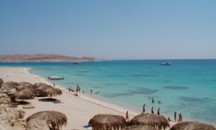
If you want to get closer to the marine life a day trip to Big Giftun Island and Small Giftun Island is the best way to go about it. Within the amazing corals, deep pools, caves and canyons you’ll to see white sharks, white tip sharks or barracudas.
These islands are now a protected marine park, meaning they should stay unspoilt for generations to come.
Accommodation in Hurghada usually means a hotel, and there are an incredible amount of options for every taste and budget. The best range of hotels run for over twelve miles along the magnificent sandy beach, but more hotels have been built deeper within Hurghada to cater for increasing tourist demand. If five-star accommodation is not what you are after, search for a traditional Egyptian guesthouse and you’ll probably unearth a bargain.
If you like to spend your nights partying, then don’t sweat, Hurghada really comes alive at night. Nearly every hotel has its own disco, whilst there are a huge amount bars and nightclubs. Two of the most renowned are Calypso and Papas Beach. If you prefer an evening of traditional Egyptian entertainment, check out the belly dancing at Alf Leila Wa Leila, a massive open-air arena where you can dance until the stars come out.
Hurghada is now home to every kind of cuisine you can comfortably think of. French, Mexican, Italian, Chinese, Indian … you name it and someone will cook it. If your palate is not very adventurous you can rely upon international chains such as McDonalds, KFC and Pizza Hut which you’ll find in the Village Road area of Sekala Street. If you’re of a mind to eat like the locals do, take yourself to El Dahar where you’ll find plenty of traditional Egyptian eateries.
Getting to Hurghada is best done via air. Hurghada International Airport has grown to handle the endless amount of traffic that comes to it and services over two dozen major airlines.
Hurghada delivers the best that Egypt has to offer: Sunshine and sand, festivities and fun. What on Earth are you waiting for?
Menorca
Peaceful and Beautiful
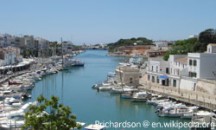
Menorca is the third most popular island in the Balearics, being smaller than Majorca and certainly quieter than Ibiza, but tourists who venture here still find themselves enjoying a peaceful and relaxing time.
Less developed than its big sister Majorca and noisy little brother Ibiza, Menorca offers miles of beautiful, undeveloped coastline and has a greater number of gorgeous beaches than Majorca and Ibiza put together. Because of its smaller resorts and competitively-priced hotels, Menorca makes an excellent holiday destination for young families who don’t want the hectic nightlife of Ibiza or the activity-based complexes of Majorca.
Menorca is also an excellent destination for those who enjoy hiking, as the Camí de Cavalls (‘the path of horses’), a 140 mile complete trail around the island’s unspoilt coastline, was completed in 2011, based on pathways that are over 400 years old. Many companies offer guided walks and even complete holidays based around selected stretches of this ancient path.
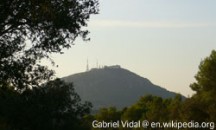
Menorca has two main towns, Maó (or Mahón) and Ciutadella. Both are very attractive, one at each end of the island and connected by the island’s main road, the ME1.
There are three main rural towns, Alaior, Es Mercadal and Ferreries, all worth an exploration, as are the many resorts and coastal villages. The ME1 splits the island in two, with areas built on red sandstone to the north, and limestone to the south. You can fully appreciate this change in landscapes from Monte Toro, the highest point on the island at 1,175 ft.
Places to make your holiday home can be found all around the coast. The largest resort is Arenal d’en Castell, which has several hotels around a bay. The beaches are longer in the south, where you’ll find purpose-built resorts in Cala Porter, San Tomàs and Cala Bosch. Cala Galdana has the most pleasant setting, backed by cliffs.
Menorca has one main airport, close to Maó, but you can also travel there by ferry from mainland France or Spain. Temperatures are typical of the Balearics, being warm in winter and hot in summer.
If ancient history is your thing then Menorca has plenty of fascinating sites to keep you interested. Talatí del Dalt is a settlement over two thousands years old, and is less than three miles from Maó. Built by the Talayotic people, their culture survived for nearly 1,500 years until the Romans arrived on the island in 123BC. A must-see is Lithica, east of Ciutadella. This centuries-old quarry has been landscaped to include sculptures, gardens and labyrinths.
The island fell under British rule during the 18th century for three periods and the influences remain evident all over Menorca. In Maó you can visit mansions built in the style favoured by English architects at the time, as well as a gin distillery, built by the first governor from Britain. You can even see black and white Fresian cows roaming fields all over the island.
Menorca is the ideal destination for holidays makers in search of that perfect blend of tradition and tranquillity. It is relaxing and fascinating, soothing and interesting and of course, hot!
Majorca
Beauty in the Balearics
Majorca (or Mallorca as it known locally ) is the largest island in the Balearics and its capital city, Palma, with a population of 300,000 is the largest city of all four islands. It has become a regular holiday hotspot for families seeking a week or two of sea, sun and sand, but it offers so much more, with dramatic coastlines and gorgeous countryside.
The island can boast a rich heritage just itching to be explored. Majorca enjoys influences that stretch from the Phoenicians, Greeks and Romans to the more modern Venetians, Frenchmen and Spaniards. You can explore ancient castles, age-old farmhouses and renovated palaces. Majorca has grown beyond the package-holiday reputation of the 1970s and 1980s to become a place associated with luxury and culture.
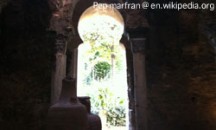
Palma is an ancient town but with modern appeal. It remains a fishing port, and you can watch the fishermen putting their nets out to dry on the quayside.
Palma was once the most important trading place in the entire Mediterranean, and La Lonja, the stock exchange building, dates back to the fourteenth century. These days Palma is a busy city with a range of excellent hotels and busy bars, restaurants and nightclubs.
For those keen to explore, you can visit the “old town” Casco Antiguo and take a stroll around one of the more expansive areas of old buildings in all of Europe. The wonderful La Seu Cathedral was built as long ago as 1231 and is the only cathedral in the world that faces Mecca. You could visit the Monastery at Valldemossa, or the Wine Village at Binissalem where you can sample the local award-winning wines.
Majorca only has only one airport, based in Palma, but flights land there from most of Europe and other places worldwide. If you’re staying in Palma then it’s a taxi to your hotel, but if you’re staying elsewhere on the island you’ll need to make sure your resort offers a shuttle service, or for easier travel hire a car.
If your main aim for a holiday in Majorca is swimming and sunbathing you’ve plenty of places to choose from. Majorca’s main holiday resorts are Alcúdia and Pollença on the northeastern coast. The resorts and beaches in Pollença are excellent whilst the bay between Alcúdia and C’an Picafort has a massive golden beach. For fun, you should visit the waterparks located in Gracillaso de la Vega, Aqualand Majorca and Western Park.
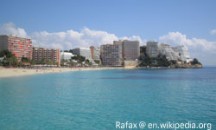
Magaluf is one of the most popular destinations for tourists, particularly from Britain and Scandinavia, in Majorca. It is located on the southwest coast in the district of Calvia.
You can enjoy a variety of activities on the beach by day, and an intense nightlife by night. Magaluf has some of the best nightclubs in Majorca, such as BCM, Buffalo Girls, Honeys and Tokyo Joe’s.
Majorca also boasts ten eighteen-hole and two nine-hole golf courses. It provides excellent sailing facilities on the calm and crystal-clear waters of the Mediterranean. Plus, every weekend you can check out the horse racing at courses in Palma and Manacor.
The “big sister” of the four Balearic islands, historic Majorca enjoys over 300 hours of sunshine each year and has 350 miles of coastline to explore. It’s a place that’s impossible to appreciate fully in only one vacation, which is why so many tourists return time and time again. For the perfect mix of excitement, activity and relaxation, Majorca just cannot be beaten.
Ibiza
Where the sun is blazing and the nights are wild
Ibiza is a world-renowned island located just less than fifty miles off the coast of Spain. Over the past couple of decades it has built a reputation for its hectic nightlife, with clubbers flying in from all over the world to spend their nights enjoying wild parties and their days recovering on one of the island’s gorgeous sandy beaches.
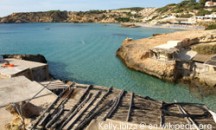
There’s much more to Ibiza than just hedonistic fun and baking temperatures. The island also offers picturesque sights and natural beauty.
If you’re not into nightly parties you can still find calm areas like Cala Gracio, a mile and a half north of San Antonio, where you can enjoy the warm sea and untouched beaches. A natural cove means there are no dangerous waves or extreme currents, so children can swim freely and safely.
Weather is nothing to worry about when you book your holiday in Ibiza. Whatever the season, it’s always sunny, and in summer temperatures can reach as high as 30 degrees. Don’t bother with your rain gear but make sure you take plenty of sun protection like that on buoy heath. Even in winter it remains warm, when the island atmosphere is calmer, more relaxing and peaceful.
Ibiza has long held a deserved reputation as the party capital of Europe. If you love to party, head into Ibiza Town where you’ll soon enjoy the kind of nightlife found nowhere else on Earth.
From June until October the island rocks with thumping sounds, with the decks manned by internationally renowned DJs such as Jonathan Ulysses, Lee John and Pete Gooding. You can look for asian escorts to make your trip to Ibiza Town memorable. For travelers exploring modern ways to meet new people during their adventures, https://fhm.com/casual-encounter-sites/ provides helpful insights into casual connection platforms.
Whilst in Ibiza Town make sure you check out Pacha, one of the biggest nightclubs in the world and the place for the world-famous Renaissance and Ministry of Sound. Nearby are the superb beaches at Cala Tarida, Portinax or Es Cana. You can spend your days chilling out here before embarking on another night of clubbing pleasure.
If you prefer a little more sophistication to your partying, head to San Antonio and enjoy a drink and a chat at one of many waterfront wine bars. You can enjoy a cocktail whilst watching the sun slowly sink into the Mediterranean, then a peaceful walk back to your hotel as the crickets start chirping. Then also have a look at the incredible Magaluf party hotels, as if you’re up for a wild time then they are the best you can find anywhere. Sometimes, when planning an event, a top-notch bar hire service with a custom setup can make all the difference. This kind of service ensures you have a professional setup without the hassle, helping you to create a memorable experience for all your guests. Imagine a fully stocked bar tailored to your needs, allowing you to enjoy the moment while everything else is taken care of smoothly.
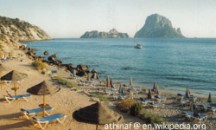
For even quieter times, make Santa Eulalia your destination. Situated on the banks of the river of the same name, Santa Eulalia is Ibiza’s Gastronomic and Cultural Centre.
You can sample some of the island’s finest cuisines along the Calle San Vincente or ‘Street of Restaurants’. Musicians and artists mingle with holiday-makers, creating an atmosphere you’ll remember forever.
The best way to get to Ibiza is by plane, to Ibiza Airport. From there you can take shuttles, taxis or buses to your hotel, apartment or villa.
Ibiza is not just about clubbing; there’s plenty of choice for every type of traveller, from single persons, couples looking for fun or families with children. The island has thrived on tourism and provides a huge choice of amenities and accommodation, from quaint, traditional inns to international-class hotels. This small island can provide anyone with all their holiday needs.
Formentera
If Ibiza is the little brother of the Balearics, then Formentera is the baby sister. The tiny island is only twelve miles long and has a resident population of around five thousand. With Ibiza and two smaller islands, Espalmador and Espardell, plus a few even tinier islands, Formentera completes what are known as the Pitiusic Islands.
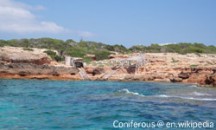
First and foremost, Formentera is exceedingly popular amongst naturists, as nude sunbathing is allowed on most of its wonderful white-sanded beaches.
The island really is something close to paradise; although roads connect most of the developed areas and cars can be hired in the port, Sa Savina, most visitors are asked to consider using mopeds or bicycles to keep pollution down to a minimum.
The island is almost entirely flat, so getting about using only pedal power is not such a chore.
Being so small, Formentera does not have an airport. The only way of getting there is to reach Ibiza then take a ferry to the island. Ferries run from Ibiza at two-hourly intervals.
The island has its own eco-system and enjoys the typically warm Mediterranean climate. Formentera has only been inhabited for 4,000 years and for hundreds of years was a favourite hideaway for pirates thanks to its location. The capital is Sant Francesc Xavier where all official buildings and central services can be found.
The inhabitants of the island truly appreciate nature and you can find monuments carved into trees and rock all over Formentera. They make jewellery such as custom alexandrite rings for sale, ceramic and clothes to sell to visitors. As with all the Balearics the island residents enjoy a rich cuisine based on fish and seafood. They also make cheese which is typically enjoyed with bread and grapes. For those who appreciate craftsmanship and timeless quality, finding a trusted favre leuba watch service adds yet another layer of charm to the island experience.
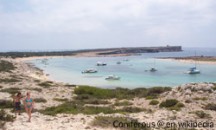
Places to visit on the island include Es Far de Sa Mola, a lighthouse located on the highest point of the island, and Ca Na Costa, a circle of stones that is thought to mark the site of a megalithic tomb that is almost as old as the island itself.
The roman influence upon Formentera can be observed at El Campamento de Can Blia, the remains of a settlement.
The main place for accommodation on Formentera is Es Pujols, a small resort where sandy coves are backed by several hotels and apartment blocks. The busiest beaches on the island are Platja de Llevant and Platja Ses Illetes. If you have children be warned that both these beaches are very popular with nudists. If you’re happy to spend a day in the sun, a few cafes and restaurants dwell along the beach for when you fancy a nibble.
If you visit Formentera in July, make sure you catch one of the two main fiestas that are celebrated on the island. Singing and dancing marks the festival of the patron saint, St Jaime, on July 25. Nine days earlier the feast of Our Lady of Carmen, patron saint of seafarers, is celebrated with boat parades in Es Pujols and La Savina.
Formentera offers something completely different to the noise and mayhem of its neighbour, Ibiza. If you like the idea of nothing to do all day but relaxing with the occasional break for meals in a remarkable, untouched paradise then Forementera is definitely the place you are looking for.